Michael J. Kramer's Blog, page 22
July 31, 2022
2022 October 01—The Berkeley Folk Music Festival & the Northern California Counterculture
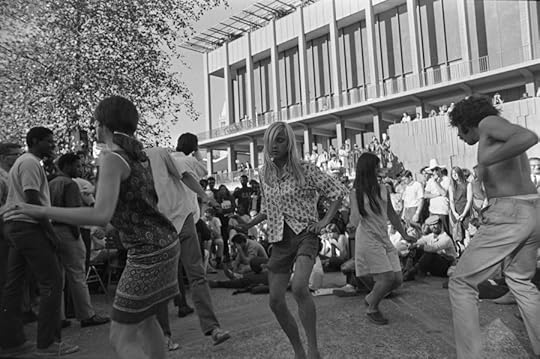 Dancers on Sproul Plaza at the University of California during the 1967 Berkeley Folk Music Festival. From the Berkeley Folk Music Festival Archive, Charles Deering McCormick Library of Special Collections, Northwestern University Libraries.
Dancers on Sproul Plaza at the University of California during the 1967 Berkeley Folk Music Festival. From the Berkeley Folk Music Festival Archive, Charles Deering McCormick Library of Special Collections, Northwestern University Libraries.I will be presenting the story of the Berkeley Folk Music Festival and the Northern California Counterculture at the upcoming conference Contested Legacies: The Counterculture After Fifty in San Francisco. There will also be panels on various aspects of the 1960s counterculture. I will be chairing the Music and Counterculture Working Group, which features an amazing lineup of scholars.
More about the Contested Legacies: The Counterculture After Fifty Conference.More about the Berkeley Folk Music Festival Project.30 September-01 October 2022—The Berkeley Folk Music Festival & the Northern California Counterculture
 Dancers on Sproul Plaza at the University of California during the 1967 Berkeley Folk Music Festival. From the Berkeley Folk Music Festival Archive, Charles Deering McCormick Library of Special Collections, Northwestern University Libraries.
Dancers on Sproul Plaza at the University of California during the 1967 Berkeley Folk Music Festival. From the Berkeley Folk Music Festival Archive, Charles Deering McCormick Library of Special Collections, Northwestern University Libraries.I will be presenting the story of the Berkeley Folk Music Festival and the Northern California Counterculture at the upcoming conference Contested Legacies: The Counterculture After Fifty in San Francisco. There will also be panels on various aspects of the 1960s counterculture. I will be chairing the Music and Counterculture Working Group, which features an amazing lineup of scholars.
More about the Contested Legacies: The Counterculture After Fifty Conference.More about the Berkeley Folk Music Festival Project.July 30, 2022
2022 August 25—Alan Lomax’s Transatlantic Ballad
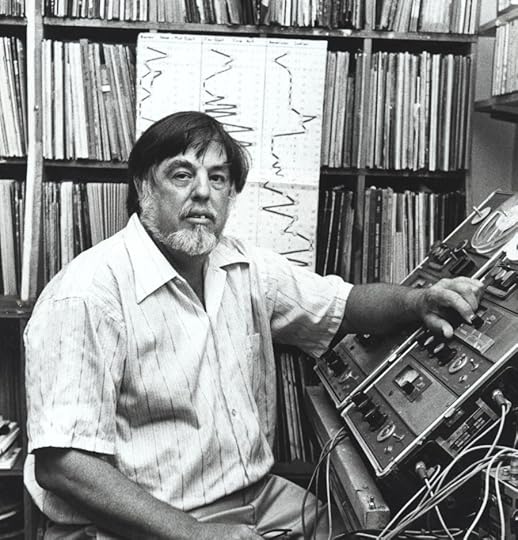
I will be virtually delivering the paper “Alan Lomax’s Transatlantic Ballad: The Modern and the Traditional in Alan Lomax’s Song Performance Style Studies” as part of the panel Modern Imaginaries (Re)built in Contemporary Americas – Connected Histories Approaches at the XXIII International Congress of Historical Sciences, held in hybrid format—online and in person—in Poznań, Poland.
The full essay will be published soon at Transatlantic Cultures.
July 15, 2022
Presenting the Past For the Future
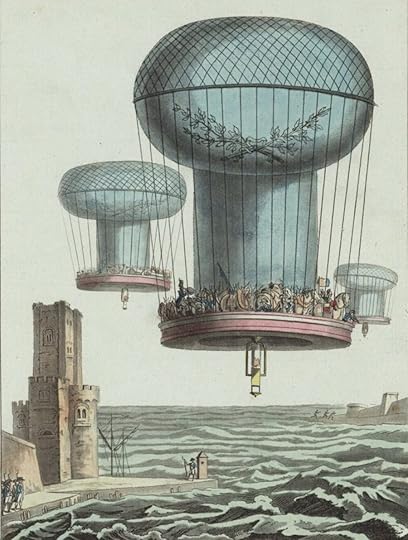 Argaud de Barges, La Thiloriere ou Descente en Angleterre: Projet d’une Montgolfiere capable d’enlever 3.000 Hommes et qui ne coutera que 300.000 Francs [etc.], etching and pointillé gravure (Paris: Chez Boulard, 1803), Bibliothèque nationale de France.
Argaud de Barges, La Thiloriere ou Descente en Angleterre: Projet d’une Montgolfiere capable d’enlever 3.000 Hommes et qui ne coutera que 300.000 Francs [etc.], etching and pointillé gravure (Paris: Chez Boulard, 1803), Bibliothèque nationale de France.The past does not exist independently from the present. Indeed, the past is only past because there is a present, just as I can point to something over there only because I am here. But nothing is inherently over there or here. In that sense, the past has no content. The past—or, more accurately, pastness—is a position. Thus, in no way can we identify the past as past.
— Michel-Rolph Trouillot
June 30, 2022
Rovings
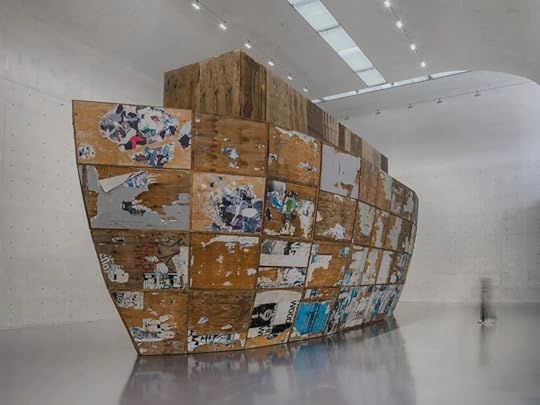 Mark Bradford, Mithra.SoundsRelational City Active Citizen Sound ArchiveCaetano Veloso and Gilberto Gil, “Haiti,” Tropicalia 2Pharis and Jason Romero, Tell ‘Em You Were GoldVarious Artists, Tribute To The Anthology Of American Folk Music By Harry SmithWalter Smith and Friends, Vols. 1-3Bob Wills and His Texas Playboys, The Tiffany Transcriptions, Vol. 1 (Recorded Live in San Francisco)Huddie “Leadbelly” Ledbetter, “John Hardy” Solar, Season 01Blood Ties, Season 03The Triangle, Season 01Archie Shepp and Jason Moran, Let My People GoGreg Osby and Florian Arbenz, Reflections of the Eternal LineSun Ra and His Arkestra, “Rocket #9”Sun Ra and His Arkestra, Music from Tomorrow’s World, Live at Wonder Inn, 1960Entourage Music and Theatre Ensemble, The Mermaid’s Purse: Live at Chatham College, 1976Zadie Smith with the BBC Symphony Orchestra, Drama on 3, BBC SoundsRadio Is A Foreign Country: Electro-Folk Sounds of North Sumatra, Aquarium DrunkardWordsIan Alteveer, Hannah Beachler, and Sarah Lawrence, with an essay by Michelle D. Commander and a graphic novella by John Jennings, Before Yesterday We Could Fly: An Afrofuturist Period Room, The Metropolitan Museum of Art Bulletin, 79, 3 (Winter, 2022)Alex Riggs, “‘Pessimism of the Intellect, Optimism of the Will’? Mood and American Democratic Socialist Ideas,” JHI Blog, 1 June 2022Timothy Brennan, “What Was Deconstruction?,” Chronicle of Higher Education Review, 3 June 2022Joe Heim, “A Savior of Abandoned American Music Contemplates His Collection,” Washington Post, 5 June 2022Eric Schatzberg, Technology: Critical History of a ConceptIan Beacock, “The Democracy Walt Whitman Wanted,” Soapbox, New Republic, 26 October 2021Christina Dunbar-Hester, “Listening to Cybernetics: Music, Machines, and Nervous Systems, 1950-1980,” Science, Technology, & Human Values 35, 1 (January 2010): 113–39Vincent Mosco, The Digital Sublime: Myth, Power, and CyberspaceJer Thorp, Living in Data: A Citizen’s Guide to a Better Information FutureMalcolm Harris, “Back to Class,” Intelligencer, New York Magazine, 09 June 2022Paul Younquist, A Pure Solar World: Sun Ra and the Birth of AfrofuturismJames Livingston, “Wonking Out With Marx: What Goes Missing in Class Analysis,” Politics, Letters, Persons Substack, 13 June 2022Julia Brock and Jennifer Sutton, “Speech Melody: An Interview with Sorrel Hays,” Southern Cultures, 6 June 2022Bradford Bailey, “On Two Stunning Archival Releases By Simone Forti,” The Hum, 8 June 2018Nicolas Nova, A Bestiary of the Anthropocene: Hybrid Plants, Animals, Minerals, Fungi, and Other SpecimensMichael Duncan and Kristine McKenna, eds., Semina Culture: Wallace Berman & His CircleSandra Leonard Starr, Lost and Found in California: Four Decades of Assemblage Art“Walls”American Artist, Shaper of God @ REDCATShirley Tse, Lompoc Stories @ Shoshana Wayne GalleryMark Bradford, Mithra @ Los Angeles State Historic ParkJohn Koller, Nano Rubio, and Michael Freitas Wood, Surface Play @ Launch GalleryThe Lost Murals of Renaissance Rome @ Getty MuseumFlesh and Bones: The Art of Anatomy @ Getty Research InstituteThis Is Not the American Flag @ The BroadShiraga Kazuo, Untitled, 1962 @ White Cube Online GalleryDavid Salle @ Gladstone GalleryLiz Larner, below above @ Regen ProjectsUnsettled Ground: Art and Environment from the Smart Museum Collection @ Smart MuseumNothing is to be Done for William T. Wiley @ Parker GalleryBeautiful Diaspora / You Are Not the Lesser Part @ Museum of Contemporary PhotographyErnesto Neto, Between Earth and Sky @ Tanya Bonakdar GalleryArchive of the World: Art and Imagination in Spanish America, 1500–1800 @ LACMAAmerican Art Galleries, European Art Galleries @ The Huntington“Stages”Arlekin Theater, The Orchard @ Arlekin Theater Online, 14 June 2022Andrew Neumann, The Predictability of Unpredictability @ RouletteCarl Hancock Rux, Carrie Mae Weems, and Meshell Ndegeocello, The Baptism @ REDCAT, 09 June 2022Bruce Molsky and Tony Trischka, Stay Home Sessions @ Caffe Lena, 9 February 2019Terrie Ex and Ken Vandermark Duo @ Elastic Arts, 2 June 2022Pan Afrikan Peoples Arkestra @ REDCAT, 4 June 2022ScreensRebels of the Neon GodObi-Wan KenobiManhattan, Seasons 01 and 02The Game, Season 01Duet for CannibalsOrnette Coleman, “Dancing In Your Head” (Live) @ Yomiuri Land Open Air Theatre East, Tokyo, 1986Christian Marclay on Night Music, 20 October 1989Bob Dylan and others, “Happy Birthday to Brian Wilson” @ Brian Wilson YouTube Channel, 20 June 2022
Mark Bradford, Mithra.SoundsRelational City Active Citizen Sound ArchiveCaetano Veloso and Gilberto Gil, “Haiti,” Tropicalia 2Pharis and Jason Romero, Tell ‘Em You Were GoldVarious Artists, Tribute To The Anthology Of American Folk Music By Harry SmithWalter Smith and Friends, Vols. 1-3Bob Wills and His Texas Playboys, The Tiffany Transcriptions, Vol. 1 (Recorded Live in San Francisco)Huddie “Leadbelly” Ledbetter, “John Hardy” Solar, Season 01Blood Ties, Season 03The Triangle, Season 01Archie Shepp and Jason Moran, Let My People GoGreg Osby and Florian Arbenz, Reflections of the Eternal LineSun Ra and His Arkestra, “Rocket #9”Sun Ra and His Arkestra, Music from Tomorrow’s World, Live at Wonder Inn, 1960Entourage Music and Theatre Ensemble, The Mermaid’s Purse: Live at Chatham College, 1976Zadie Smith with the BBC Symphony Orchestra, Drama on 3, BBC SoundsRadio Is A Foreign Country: Electro-Folk Sounds of North Sumatra, Aquarium DrunkardWordsIan Alteveer, Hannah Beachler, and Sarah Lawrence, with an essay by Michelle D. Commander and a graphic novella by John Jennings, Before Yesterday We Could Fly: An Afrofuturist Period Room, The Metropolitan Museum of Art Bulletin, 79, 3 (Winter, 2022)Alex Riggs, “‘Pessimism of the Intellect, Optimism of the Will’? Mood and American Democratic Socialist Ideas,” JHI Blog, 1 June 2022Timothy Brennan, “What Was Deconstruction?,” Chronicle of Higher Education Review, 3 June 2022Joe Heim, “A Savior of Abandoned American Music Contemplates His Collection,” Washington Post, 5 June 2022Eric Schatzberg, Technology: Critical History of a ConceptIan Beacock, “The Democracy Walt Whitman Wanted,” Soapbox, New Republic, 26 October 2021Christina Dunbar-Hester, “Listening to Cybernetics: Music, Machines, and Nervous Systems, 1950-1980,” Science, Technology, & Human Values 35, 1 (January 2010): 113–39Vincent Mosco, The Digital Sublime: Myth, Power, and CyberspaceJer Thorp, Living in Data: A Citizen’s Guide to a Better Information FutureMalcolm Harris, “Back to Class,” Intelligencer, New York Magazine, 09 June 2022Paul Younquist, A Pure Solar World: Sun Ra and the Birth of AfrofuturismJames Livingston, “Wonking Out With Marx: What Goes Missing in Class Analysis,” Politics, Letters, Persons Substack, 13 June 2022Julia Brock and Jennifer Sutton, “Speech Melody: An Interview with Sorrel Hays,” Southern Cultures, 6 June 2022Bradford Bailey, “On Two Stunning Archival Releases By Simone Forti,” The Hum, 8 June 2018Nicolas Nova, A Bestiary of the Anthropocene: Hybrid Plants, Animals, Minerals, Fungi, and Other SpecimensMichael Duncan and Kristine McKenna, eds., Semina Culture: Wallace Berman & His CircleSandra Leonard Starr, Lost and Found in California: Four Decades of Assemblage Art“Walls”American Artist, Shaper of God @ REDCATShirley Tse, Lompoc Stories @ Shoshana Wayne GalleryMark Bradford, Mithra @ Los Angeles State Historic ParkJohn Koller, Nano Rubio, and Michael Freitas Wood, Surface Play @ Launch GalleryThe Lost Murals of Renaissance Rome @ Getty MuseumFlesh and Bones: The Art of Anatomy @ Getty Research InstituteThis Is Not the American Flag @ The BroadShiraga Kazuo, Untitled, 1962 @ White Cube Online GalleryDavid Salle @ Gladstone GalleryLiz Larner, below above @ Regen ProjectsUnsettled Ground: Art and Environment from the Smart Museum Collection @ Smart MuseumNothing is to be Done for William T. Wiley @ Parker GalleryBeautiful Diaspora / You Are Not the Lesser Part @ Museum of Contemporary PhotographyErnesto Neto, Between Earth and Sky @ Tanya Bonakdar GalleryArchive of the World: Art and Imagination in Spanish America, 1500–1800 @ LACMAAmerican Art Galleries, European Art Galleries @ The Huntington“Stages”Arlekin Theater, The Orchard @ Arlekin Theater Online, 14 June 2022Andrew Neumann, The Predictability of Unpredictability @ RouletteCarl Hancock Rux, Carrie Mae Weems, and Meshell Ndegeocello, The Baptism @ REDCAT, 09 June 2022Bruce Molsky and Tony Trischka, Stay Home Sessions @ Caffe Lena, 9 February 2019Terrie Ex and Ken Vandermark Duo @ Elastic Arts, 2 June 2022Pan Afrikan Peoples Arkestra @ REDCAT, 4 June 2022ScreensRebels of the Neon GodObi-Wan KenobiManhattan, Seasons 01 and 02The Game, Season 01Duet for CannibalsOrnette Coleman, “Dancing In Your Head” (Live) @ Yomiuri Land Open Air Theatre East, Tokyo, 1986Christian Marclay on Night Music, 20 October 1989Bob Dylan and others, “Happy Birthday to Brian Wilson” @ Brian Wilson YouTube Channel, 20 June 2022
June 8, 2022
Chance Operations
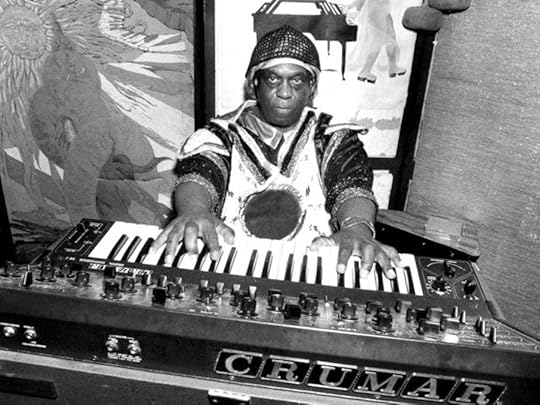 Sun Ra. Photo: Veryl Oakland.
Sun Ra. Photo: Veryl Oakland.Politics, religion, philosophy have all been tried, but music has not been given a chance.
— Sun Ra
Simone Forti’s Hands
 Video still from Weeding: Simone’s Garden, filmed by Jason Underhill.
Video still from Weeding: Simone’s Garden, filmed by Jason Underhill.Like an ensemble of ten dancers, Simone Forti’s fingers were moving against the wall. Actually, a large video projection of her hands in a garden in Vermont was moving on the wall. She was weeding. Talking and weeding.
She was doing so in her own garden and in fellow dancer and choreographer Steve Paxton’s garden on the semi-famous Mad Brook Farm, a commune where Forti herself used to live. Yet as the camera zoomed in close, so that all we saw was leaves, dirt, nails, knuckles, fingertips, white and pink and specked with soil against the green and peat, the scale of the dance shifted from the human to the prehensile.
The video would pan out or cut to Forti herself at times, but it was the hands that really mattered, that got your attention. Even the various objects from across Forti’s long career in contemporary dance and art that punctuated the gallery rooms themselves, either hanging from the ceiling or leaning against the walls seemed less crucial than the video images: a piece of tall rectangular plywood, a kind of unfinished beam titled Plank (1961/2022); Saw Horse (1961/2022), which is just what it sounds like it is; That Block (2016), a simple piece of weathered wood; and The Very Big Sound (2022), a gong and mallet, silent, either just rung or waiting to be struck; an old black leather jacket was crumped in a corner; on walls around the corner in another gallery were simple painted smudges on flattened brown Trader Joe’s bags, the only canvases Forti had at her disposal during the covid-19 pandemic. They all seemed to be but dreamlike variations on the textured and almost sculptural experience of Forti’s fingers: immaterial material commentary on dematerialized video of skin and bone.
Which is to say that these were the artworks in the immediate rooms, but they came to feel rather remote and unreal, as if they were floating (which some where given that they were dangling from the ceiling). They were like mere memories in the mind as much as sculptures in the space. It was the videos that moved front and center, that seemed visceral and present, that left an imprint. What was there in the gallery seemed imaginary, disembodied, like flickering Jungian symbols in a dream, while what was on projected on the screen by flickering light felt most real, embodied, and immediate.
The air was sunny and cool. Mountain air. It was either early morning or late afternoon in the Northeast Kingdom of Vermont. As one watched, there was no revelation, no waving of a magic wand, and certainly no legerdemain. We were not really meant to grasp something profound here, it would seem, in the grandiose sense—save for the importance, permeating the gallery with its glow, of the small acts of a pair of skilled hands, slightly shaky from Forti’s Parkinson’s but all the more skilled for their casual determination to pursue the task at hand. She thumbed at roots, pinched vines, perhaps sometimes grasped at straws, but just as often meditatively navigated the bramble.
The video grabbed you, pulled you in, sorted you out. Forti’s fingers started to seem like members of the Merce Cunningham Dance Company, or an ensemble performing in Yoko Ono’s loft, or a group gathered to experiment with movement on a program at Judson Church. Yet these impressions too passed into memory, mere shadows to the immediate activity cast upon the walls.
The quotidian practice of gardening began to loom large. It refused to knuckle under. It was organic yet also assertive. It was slow and graceful, but one also noticed over time how muscular, sinewy, and full of tensed energy Forti’s fingers became. They almost seemed to vibrate with potential movement, possible ideas, a thousand memories of what might come next. Something was clutched in the moment before slipping out of grasp. Below the stem, at ground level, the hands dug in, and lifted away, with digital clarity.
June 5, 2022
Theory Is a Detour
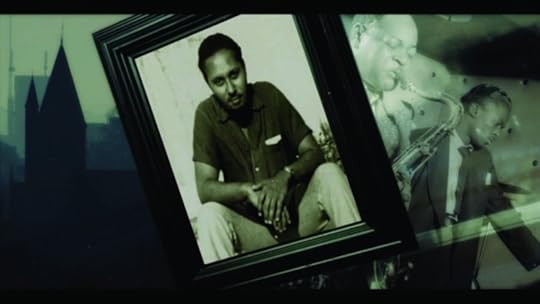
Theory is always a detour on the way to something more important.
— Stuart Hall
May 31, 2022
Rovings
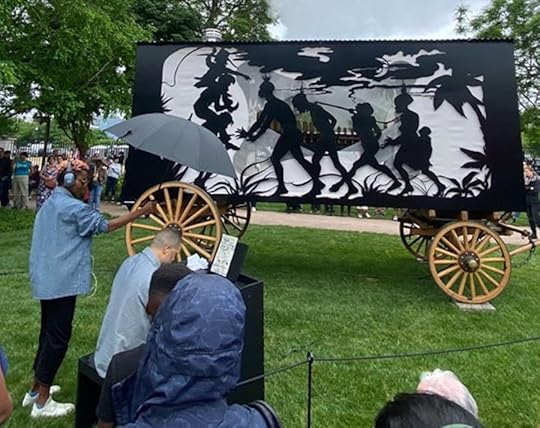 Kara Walker holds umbrella over Jason Moran as he performs at her The Katastwóf Karavan, National Gallery of Art Sculpture Garden, 14 May 2022.SoundsBelle and Sebastian, A Bit of PreviousMarti Epstein, Nebraska impromptuTom Western, Active Citizens Sound ArchiveDarby and Tarlton, “Adam and Eve” Parts 1 and 2Brinsley Schwarz, “Country Girl,” Despite It AllElvis Costello and the Imposters, The Boy Named IfLeyla McCalla, Breaking the ThermometerOur Friends in the North, BBC SoundsBlack Roots Episodes 01 and 02, BBC SoundsVarious Artists, For The Birds: Vol. 1 The Birdsong ProjectWordsGillian Jakab, “Bebe Miller and Cynthia Oliver: The legendary choreographers discuss their history together, the evolution of Cynthia Oliver’s boom!, imposed boundaries on ‘Black dance,’ and the choreographies of the pandemic,” Gagosian Quarterly, Fall 2020Rawiya Kameir, “She Drew the Hallelujah,” Bookforum, Summer 2021George W. S. Trow, “Eclectic, Reminiscent, Amused, Fickle, Perverse—I and II,” New Yorker, 22 May 1978Jason Farago, “Close Read: A Messy Table, a Map of the World,” New York Times, 8 May 2022Hazel V. Carby, “We must burn them,” London Review of Books 44, 10, 26 May 2022Dael A. Norwood, “Pacific World, Atlantic Assumptions,” The Panorama: Expansive Views from the Journal of the Early Republic, 17 May 2022Dayna Tortorici, “What Are You Looking At? Madonna’s iconic 1991 documentary,” Bookforum, June/July/August 2021Lidija Haas, “Manifesto Destiny: Writing that demands change now,” Bookforum, June/July/August 2021Kenneth Gross, “Of Angel and Puppet Klee, Rilke, and the Test of Innocence,” The Public Domain Review, 19 May 2022David A. Bell, “Distant Moments: Joan Scott and the war over the past,” The Nation, 16/23 May 2022Jay Ruby, ed., Bohemia in Southern CaliforniaHerbert Blau, The AudienceAlexander Roob, Alchemy and Mysticism: The Hermetic Museum“Walls”Luiz Zerbini: a mesma história nunca é a mesma (The same story is never the same) @ Museu de Arte de São PauloSeafaring @ Hastings ContemporaryHayao Miyazaki @ Academy Museum of Motion PicturesWillie Cole: No Strings @ Alexander and BoninNanette Carter: Shape Shifting @ Berry CampbellNari Ward: I’ll Take You There; A Proclamation @ Lehmann Maurine
Frederick Hammersley: Out of the Blue
@ LA Louver
Sculpture
@ LA Louver
Gary Simmons: Remembering Tomorrow
@ Hauser & Wirth LA
Imogen Cunningham @ Getty MuseumIn Focus: Writing for the Camera @ Getty Museum
Jamal Cyrus: The End of My Beginning
@ ICA
Simone Forti: An Other Pretty Autumn @ Box Gallery LA“Stages”Mini-Mekons @ House Concert, Los Angeles, 22 May 2022
Jason Moran @ Kara Walker’s The Katastwóf Karavan, National Gallery of Art Sculpture Garden, 14 May 2022
Vri, Chamber Folk From Wales @ Library of Congress Homegrown Plus Concerts
Nick Lowe Performs “Trombone” and “Lay It On Me” @ Rolling Stone‘s In My Room, 12 April 2020
Omar Román De Jesús, Cielo Elena @ PlayBAC, 8 May 2022
Kioto Aoki presents Sonics & Optics @ Experimental Sound Studio, 9 May 2022
Alfredo Colón, Echando Los Santos @ Roulette, 9 May 2022
Ikue Mori, Tracing the Magic @ Roulette, 24 May 2022
Trisha Brown Rehearsal Footage @ Trisha Brown Instagram Feed, 7 May 2022
ScreensPachinko, Season 01Tehran, Season 02Manhattan, Season 01Operation MincemeatThe FrenchEighty Days Around the WorldWe Own This CityGeorge Carlin’s American Dream
Some YoYo Stuff: An observation of the observations of Don Van Vliet by Anton Corbijn
Kara Walker holds umbrella over Jason Moran as he performs at her The Katastwóf Karavan, National Gallery of Art Sculpture Garden, 14 May 2022.SoundsBelle and Sebastian, A Bit of PreviousMarti Epstein, Nebraska impromptuTom Western, Active Citizens Sound ArchiveDarby and Tarlton, “Adam and Eve” Parts 1 and 2Brinsley Schwarz, “Country Girl,” Despite It AllElvis Costello and the Imposters, The Boy Named IfLeyla McCalla, Breaking the ThermometerOur Friends in the North, BBC SoundsBlack Roots Episodes 01 and 02, BBC SoundsVarious Artists, For The Birds: Vol. 1 The Birdsong ProjectWordsGillian Jakab, “Bebe Miller and Cynthia Oliver: The legendary choreographers discuss their history together, the evolution of Cynthia Oliver’s boom!, imposed boundaries on ‘Black dance,’ and the choreographies of the pandemic,” Gagosian Quarterly, Fall 2020Rawiya Kameir, “She Drew the Hallelujah,” Bookforum, Summer 2021George W. S. Trow, “Eclectic, Reminiscent, Amused, Fickle, Perverse—I and II,” New Yorker, 22 May 1978Jason Farago, “Close Read: A Messy Table, a Map of the World,” New York Times, 8 May 2022Hazel V. Carby, “We must burn them,” London Review of Books 44, 10, 26 May 2022Dael A. Norwood, “Pacific World, Atlantic Assumptions,” The Panorama: Expansive Views from the Journal of the Early Republic, 17 May 2022Dayna Tortorici, “What Are You Looking At? Madonna’s iconic 1991 documentary,” Bookforum, June/July/August 2021Lidija Haas, “Manifesto Destiny: Writing that demands change now,” Bookforum, June/July/August 2021Kenneth Gross, “Of Angel and Puppet Klee, Rilke, and the Test of Innocence,” The Public Domain Review, 19 May 2022David A. Bell, “Distant Moments: Joan Scott and the war over the past,” The Nation, 16/23 May 2022Jay Ruby, ed., Bohemia in Southern CaliforniaHerbert Blau, The AudienceAlexander Roob, Alchemy and Mysticism: The Hermetic Museum“Walls”Luiz Zerbini: a mesma história nunca é a mesma (The same story is never the same) @ Museu de Arte de São PauloSeafaring @ Hastings ContemporaryHayao Miyazaki @ Academy Museum of Motion PicturesWillie Cole: No Strings @ Alexander and BoninNanette Carter: Shape Shifting @ Berry CampbellNari Ward: I’ll Take You There; A Proclamation @ Lehmann Maurine
Frederick Hammersley: Out of the Blue
@ LA Louver
Sculpture
@ LA Louver
Gary Simmons: Remembering Tomorrow
@ Hauser & Wirth LA
Imogen Cunningham @ Getty MuseumIn Focus: Writing for the Camera @ Getty Museum
Jamal Cyrus: The End of My Beginning
@ ICA
Simone Forti: An Other Pretty Autumn @ Box Gallery LA“Stages”Mini-Mekons @ House Concert, Los Angeles, 22 May 2022
Jason Moran @ Kara Walker’s The Katastwóf Karavan, National Gallery of Art Sculpture Garden, 14 May 2022
Vri, Chamber Folk From Wales @ Library of Congress Homegrown Plus Concerts
Nick Lowe Performs “Trombone” and “Lay It On Me” @ Rolling Stone‘s In My Room, 12 April 2020
Omar Román De Jesús, Cielo Elena @ PlayBAC, 8 May 2022
Kioto Aoki presents Sonics & Optics @ Experimental Sound Studio, 9 May 2022
Alfredo Colón, Echando Los Santos @ Roulette, 9 May 2022
Ikue Mori, Tracing the Magic @ Roulette, 24 May 2022
Trisha Brown Rehearsal Footage @ Trisha Brown Instagram Feed, 7 May 2022
ScreensPachinko, Season 01Tehran, Season 02Manhattan, Season 01Operation MincemeatThe FrenchEighty Days Around the WorldWe Own This CityGeorge Carlin’s American Dream
Some YoYo Stuff: An observation of the observations of Don Van Vliet by Anton Corbijn




